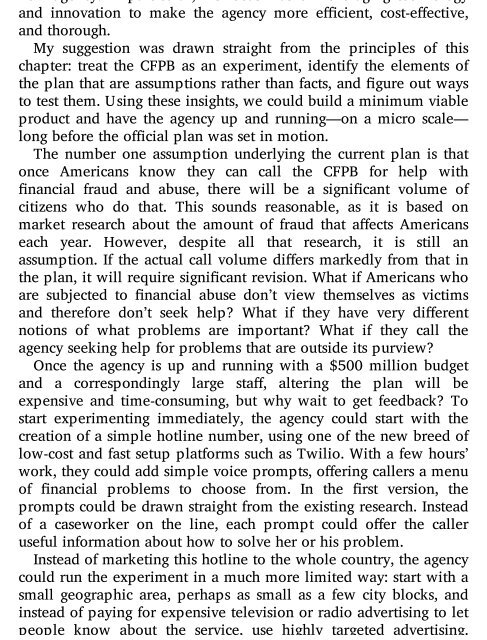Acclaim for THE LEAN STARTUP
The Lean Startup: How Today's Entrepreneurs Use Continuous ...
The Lean Startup: How Today's Entrepreneurs Use Continuous ...
- No tags were found...
Create successful ePaper yourself
Turn your PDF publications into a flip-book with our unique Google optimized e-Paper software.
and innovation to make the agency more ecient, cost-eective,<br />
and thorough.<br />
My suggestion was drawn straight from the principles of this<br />
chapter: treat the CFPB as an experiment, identify the elements of<br />
the plan that are assumptions rather than facts, and gure out ways<br />
to test them. Using these insights, we could build a minimum viable<br />
product and have the agency up and running—on a micro scale—<br />
long be<strong>for</strong>e the official plan was set in motion.<br />
The number one assumption underlying the current plan is that<br />
once Americans know they can call the CFPB <strong>for</strong> help with<br />
nancial fraud and abuse, there will be a signicant volume of<br />
citizens who do that. This sounds reasonable, as it is based on<br />
market research about the amount of fraud that aects Americans<br />
each year. However, despite all that research, it is still an<br />
assumption. If the actual call volume diers markedly from that in<br />
the plan, it will require signicant revision. What if Americans who<br />
are subjected to nancial abuse don’t view themselves as victims<br />
and there<strong>for</strong>e don’t seek help? What if they have very dierent<br />
notions of what problems are important? What if they call the<br />
agency seeking help <strong>for</strong> problems that are outside its purview?<br />
Once the agency is up and running with a $500 million budget<br />
and a correspondingly large sta, altering the plan will be<br />
expensive and time-consuming, but why wait to get feedback? To<br />
start experimenting immediately, the agency could start with the<br />
creation of a simple hotline number, using one of the new breed of<br />
low-cost and fast setup plat<strong>for</strong>ms such as Twilio. With a few hours’<br />
work, they could add simple voice prompts, oering callers a menu<br />
of nancial problems to choose from. In the rst version, the<br />
prompts could be drawn straight from the existing research. Instead<br />
of a caseworker on the line, each prompt could oer the caller<br />
useful in<strong>for</strong>mation about how to solve her or his problem.<br />
Instead of marketing this hotline to the whole country, the agency<br />
could run the experiment in a much more limited way: start with a<br />
small geographic area, perhaps as small as a few city blocks, and<br />
instead of paying <strong>for</strong> expensive television or radio advertising to let<br />
people know about the service, use highly targeted advertising.




